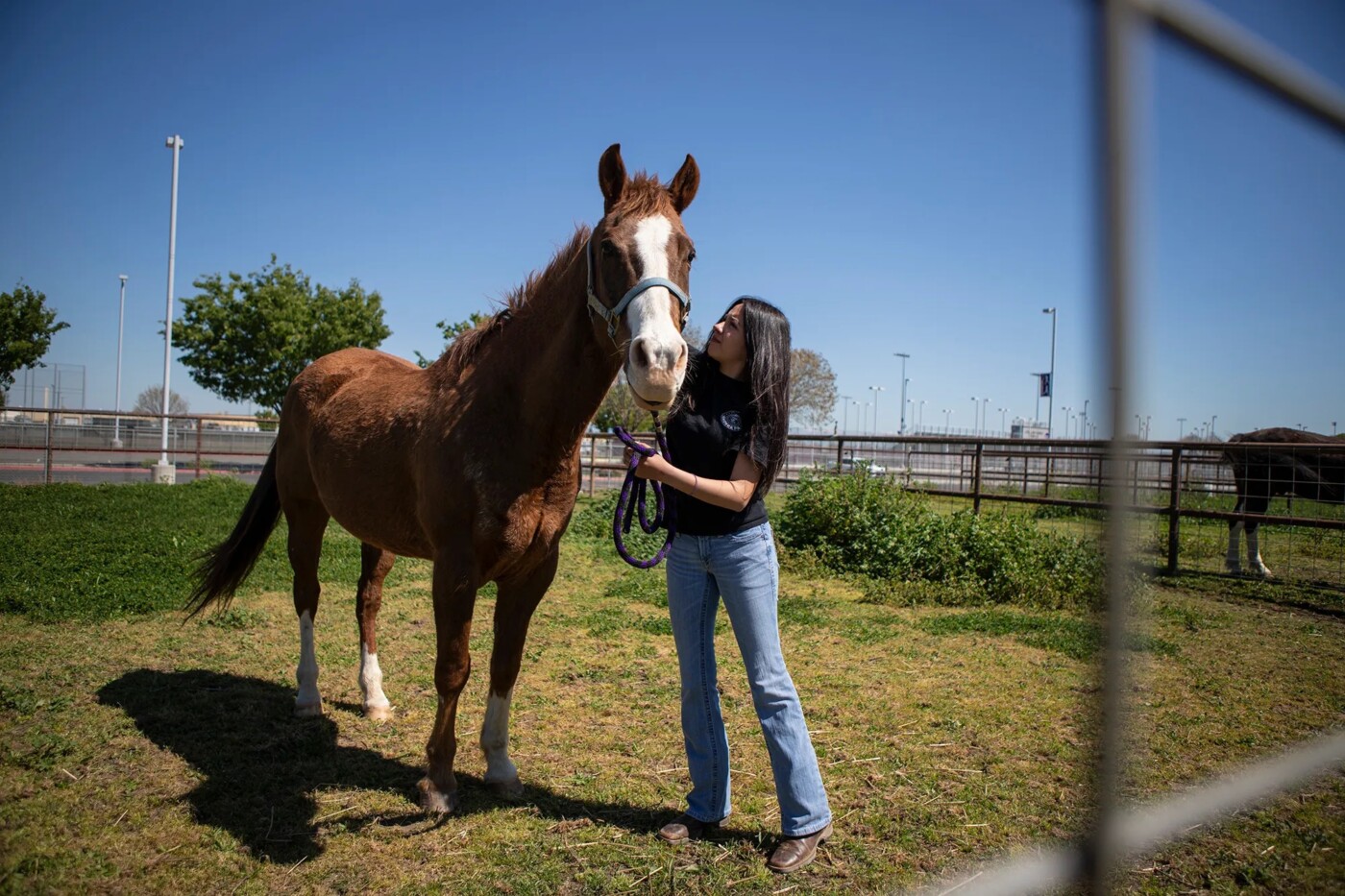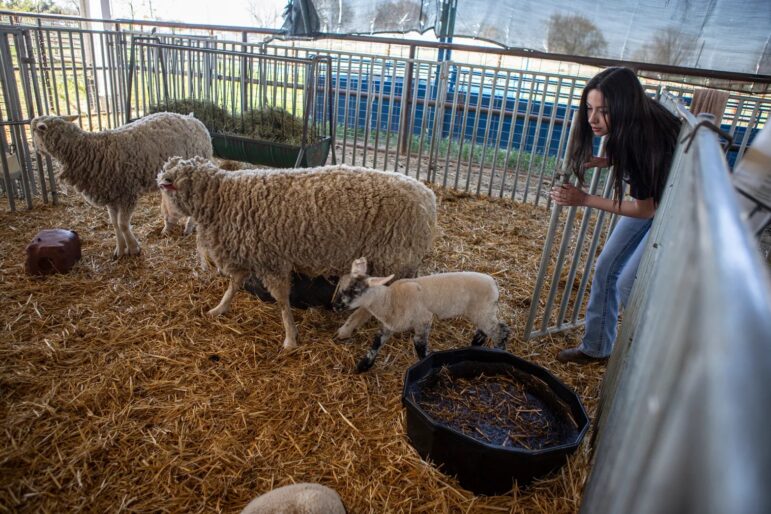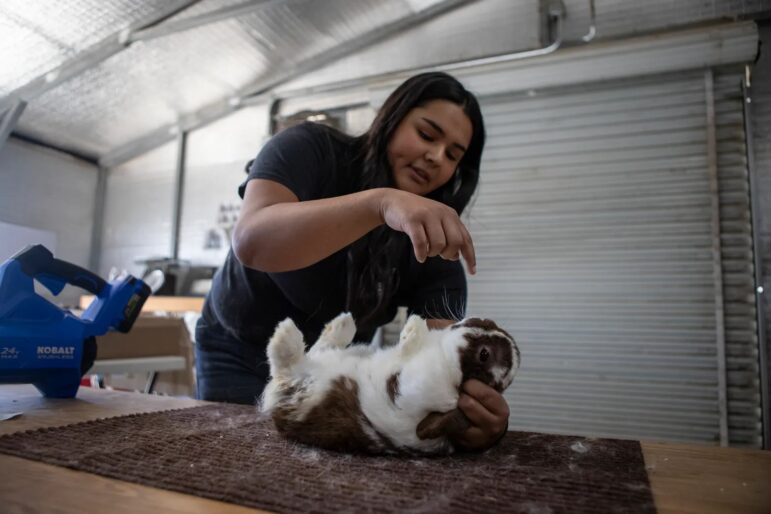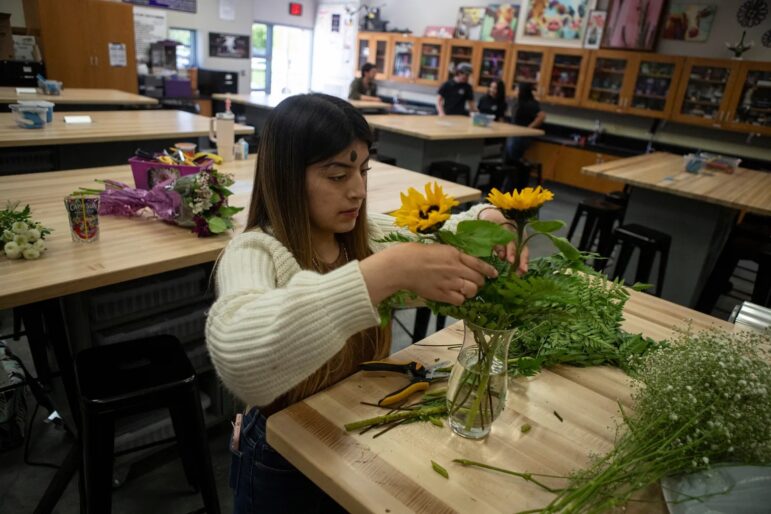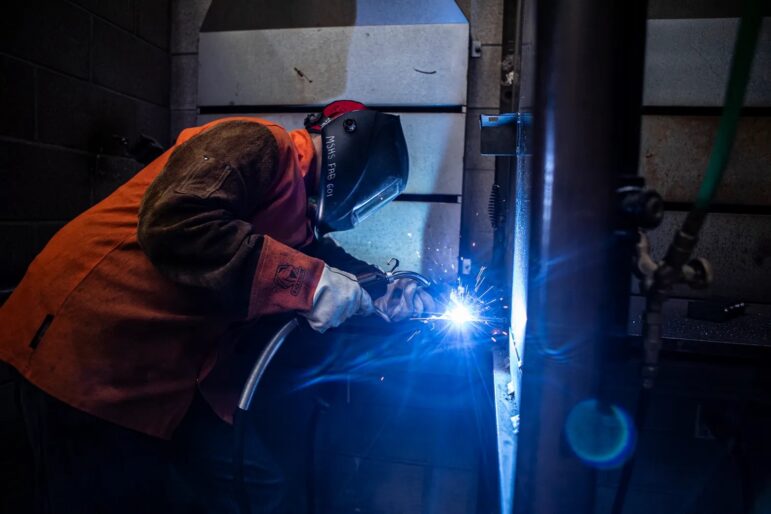A school without steers? Unthinkable, said Mason Tucker, a 10th-grader at Madera South High School north of Fresno.
“When I found out there were all these animals here, I thought, I can do this in school? I have to be here,” said Tucker, who commutes 40 minutes each way to attend the school’s agriculture program. “Why hate school when you can love it?”
Steers, sheep, horses, pigs, rabbits, chickens, a sweet-smelling tangerine grove and acres of rotating crops are part of Madera South’s agriculture pathway for students — one of thousands of career-focused courses in California high schools that are part of a renaissance in career and technical education. Aimed at preparing students for skilled, high-wage jobs, the pathways are a step beyond the vocation ed courses of generations past.
Since 2015, California has invested well over $3 billion to expand career and technical education in high schools, making it a leader nationwide. That money has translated to state-of-the-art robotics labs, welding shops, film studios and other career-preparation programs intended to spur the economy and offer students more options for their futures, whether it includes college or not.
Students seem to appreciate the opportunities. Enrollment in career pathways has jumped from 18% of all students six years ago to 23% last year. Native American, homeless and low-income students had the highest rates among student groups.
Budget uncertainty could imperil career pathway expansion
More expansion is on the way, unless the initiative falls victim to upcoming state budget cuts. Gov. Gavin Newsom’s proposed budget, released in January, calls for career education to stay intact, although that could change as negotiations continue. Last August, Newsom signed an executive order creating a Master Plan for Career Education, intended to link K-12 programs to those in community colleges and 4-year universities and streamline the dozens of career training pathways and funding sources.
Despite the surge in funding, Newsom is still a ways off from achieving his goal. While thousands of high schools in California have added or expanded their career education courses in recent years, some high schools still have scant — if any — offerings. Some courses don’t include academic content or lead to meaningful careers.
And while more students are enrolling in career preparation courses, the number should be higher, education advocates said. Ideally, all students should be taking college preparatory classes as well as career education courses, so they have the widest range of options after they graduate.
‘Once in a lifetime opportunities’
At Madera South, nearly all students are in a pathway, one of the highest rates in the state. And most of them are enrolled in the agriculture pathway, a mix of academic classes like biology and chemistry and hands-on courses such as animal science, floral design, welding and engine repair.
The school includes a 20-acre farm with ample space for livestock and raising crops. Much of the program is self-supporting, as students sell eggs, produce, floral arrangements and animals to their classmates and the community. State grant money has allowed the school to invest in field trips to local nurseries, processing plants and farms, and new equipment, such as a pair of ultrasound machines for students to see how many babies a sheep is carrying.
“It used to be, money was tight,” said Kristin McKenna, the district’s director of college and career readiness. “We couldn’t do a lot of things we wanted to. But now we have state-of-the-art equipment that’s comparable to what’s actually being used in the industry. … It gives students once-in-a-lifetime opportunities they’re not going to get elsewhere.”
Tucker and his classmates spend hours a day, even in the summer, tending to livestock and growing pumpkins and corn. Brianna Ramirez, a sophomore, said she’s motivated by the gratitude from community members.

“When I see the families line up for our corn, and they tell us how good it is, it’s just an amazing feeling,” Ramirez said. “People say I’m crazy for being out here at 6 a.m. pulling weeds all summer, but I love it.”
Ramirez, who aspires to be a horse trainer or veterinarian, said her grandparents were farmworkers for years and were initially baffled by her interest in agriculture.
“At first they were like, why is she always with the sheep? Now, it’s ‘Damn, that girl is always busy,’ ” Ramirez said. “My goal is to always make them proud. … I want to keep the ag part of my family going.”
Career programs, once known as vocational education, have been in high schools for at least a century, but were often criticized for tracking students — particularly those who were low-income – into auto shop, for example, rather than college preparatory classes.
In the 1980s, employers started pushing for stronger academic preparation in high schools so workers would be better equipped to tackle fast-changing technologies. In 1990, the federal government updated the Carl T. Perkins Vocational and Technical Education Act to require schools to integrate academic and vocational programs in order to get grant money.
These days, high-quality career preparation pathways are supposed to include academic courses as well as reflect the local job market, with input from industry leaders. In the Bay Area, that means lots of computer science pathways. Los Angeles high schools are replete with entertainment pathways to prepare students for careers in Hollywood, from acting to camerawork.
Pathways in marine transportation and global logistics
At least two schools in the Los Angeles area focus on global logistics, with support from the Ports of Long Beach and Los Angeles. In Long Beach, Cabrillo High School, which is in a largely low-income area, has a global logistics pathway where students take courses in supply chain management, international business and other topics to prepare them for careers at the port.
In one project, students analyze a country’s imports, exports and biggest trade partners. In another project, students examine a hypothetical solar panels company – where it manufactures the panels, how it ships the panels across the globe, and how logistics impact revenues.
More than 425 students are enrolled in the program, making it one of the district’s most popular.
“Students see the cranes at the port, now they know the story behind them,” said teacher Jim Dowding.
“You see students’ eyes get big and you know you’re changing lives. Not just their lives, but their family’s lives and the entire community.”
In San Pedro, a charter school called Port of Los Angeles High School offers several pathways that can lead to port jobs. Among them is a marine transportation pathway that includes classes in sailing, boat-building and navigation. Pathways in welding and construction also prepare students for jobs in the maritime industry. Partnerships with local unions allow students to enter apprentice programs after graduation.
The school is in high demand. Last year 420 students applied for 250 spots in the freshman class. Winners were chosen through a lottery.
Danica Nelson, a senior in the welding pathway, said she’s grateful to gain practical job skills. Her primary interest is theater, but she’s been able to merge the disciplines in a way she thinks will lead to a meaningful career in set construction. At school, she welded a table for a production of “Clue” and a counter for “Little Shop of Horrors.”
“I wanted to study theater but those jobs are hard to get and don’t pay that well,” Nelson said. “But with welding, I can make a good living and still be involved in theater. It’s a perfect fit for me.”
A film studio at Hollywood High
Across the county at Hollywood High, a $1 million state grant allowed the school to transform an abandoned auto shop into a state-of-the-art film studio. Students in the performing arts and media academies learn everything from animation to documentary filmmaking to stage design. One recent graduate, Cheyenne Williams, won an Emmy in 2021 for a short children’s program she directed, “Girls’ Voices Now.”
The academies are a way to guide Hollywood High students — the vast majority of whom are low-income and Latino — toward lucrative careers in the entertainment industry. Surrounded by Hollywood landmarks like the Walk of Fame and the El Capitan Theatre, the high school offers a natural training ground for future actors, lighting designers, key grips and other film set staples.
“Our students see (the entertainment industry) every day, it’s literally right in their backyard, but they don’t know how to access it,” said teacher Ali Nezu, who coordinates both academies. “We try to open those doors, give them opportunities and skills they’d never have access to otherwise, whether they decide to pursue entertainment or not.”
Higher graduation rates, better employment outlook
Research has shown that students in career education programs have higher graduation rates, improved academic achievement and higher rates of employment and enrollment in community college, said Miya Warner, a senior principal researcher with the research firm SRI.
Another benefit of high school career pathways is that the stakes are low if students change their minds. It’s relatively easy to change pathways in high school, while changing majors in college is more complicated and can cost thousands of dollars in extra coursework.
She also pointed out that college enrollment has been declining in California since 2019, as student loan debts climb and completion rates remain low. For many students, going straight from high school to a career is an appealing option.
“People are questioning college in a way they did not previously,” Warner said, adding that is happening in spite of projections that an increasing share of jobs over the next decade will require a college degree. “I think (career education) is definitely having a moment right now. It has bipartisan support, and there’s a lot of good research showing its benefits.”
She cautioned, though, that not all career education programs have the same positive outcomes. The most successful programs are tied to the local labor market and offer a sequence of linked classes, not “a la carte” offerings. Pathways should also link to high-wage careers in growing industries, not low-paying jobs with little future.
Challenges with accountability and communication
Another hurdle with career education is accountability, said David Stern, a professor emeritus at UC Berkeley who’s extensively studied the topic. Currently, the state’s main accountability measure, the California School Dashboard, uses a “college/career” indicator to count the number of students who meet the state’s college admission standards or finish a career pathway, not both. In 2023, only about 11% of students met both criteria, according to the state.
“To really reach the golden age of (career and technical education), every student should be prepared for college and career,” Stern said. “It shouldn’t be one or the other.”
He also questioned how well schools are communicating with students about their options. Most schools have skeletal counseling staffs, and some students undoubtedly sign up for a pathway because their friends are enrolled, or because someone picked it for them.
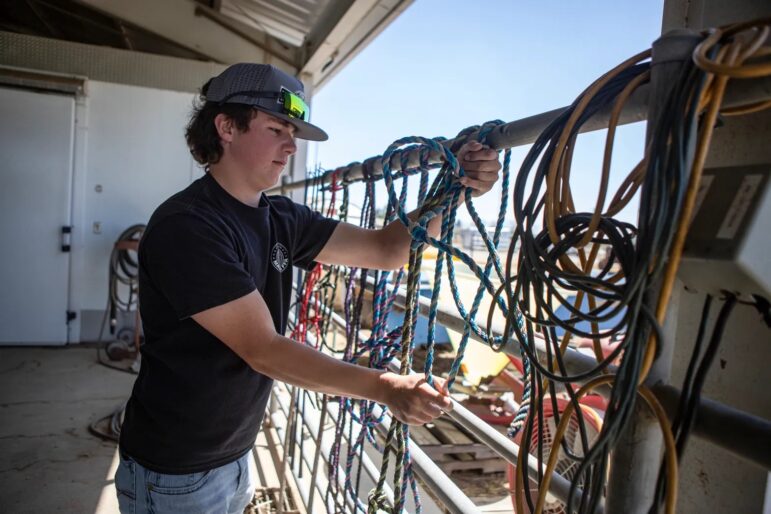
At Madera South, Tucker enjoys his time outdoors tending to animals on the campus farm, but he also loves another class in the ag pathway: welding. He recently built a steel table in six hours for a class competition, emblazoned with intricate “Madera FFA” lettering.
In addition to working on farm machinery, welding students learn to make barbecues, fire pits and other metal items. Tucker hopes to continue welding at the local community college after he graduates.
“This program is what I look forward to every single day,” Tucker said. “I feel like I’ve accomplished so much. It makes me think, what else can I accomplish in life?”
Financial support for this story was provided by the Smidt Foundation and The James Irvine Foundation.
